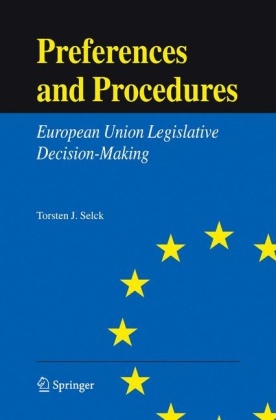Read more
Preferences and Procedures presents an tests game-theoretic models of European Union legislative decision-making. It is inspired by the idea of linking statistical testing strategies firmly to formal models of EU policymaking. After describing salient features of the EU legislative process and comparing different models of how the EU negotiates new legislative measures, the models' predictive power is evaluated. On a more general level, Preferences and Procedures answers questions regarding the empirically recognizable effects of institutional arrangements on joint bargaining outcomes.
List of contents
1: Introduction
1.1 Aim of the Book
1.2 Research Questions
1.3 The Role of Institutions
1.4 Council Voting Rules and Legislative Procedures
1.5 The Use of Models
1.6 Current Empirical Evidence
1.7 Plan of the Book
2: Conceptualizing The European Union Legislative Process: Some Insight From The Federalist Papers
2.1 Introduction: European Integration s Past and Present
2.2 Legislative Design in the European Union
2.3 Legislative Design in the United States
2.4 Decision-Making in the US and in the EU
2.5 Conclusion: Understanding the European Union Legislative Process
3: Assessing The Current State Of The Spatial Models Literature
3.1 Spatial Models of European Union Legislative Decision-Making
3.2 Competing Models
3.3 Getting the Record Straight
3.4 Conclusion: Challenges
4: Spatial Models Of Politcs: An Introduction and A Comparison Using Computer Simulation
4.1 Introduction
4.2 A Simple Model of Decision-Making
4.3 Computer Simulation
4.4 Results
4.5 Conclusion
5: A Data Set And An Analysis Of France, Germany, Italy, And The United Kingdom In EU Legislative Negotiations
5.1 Introduction
5.2 Research Design
5.3 Data Set
5.4 Analysis and Findings
5.5 Conclusion
6: Between Power And Luck: The European Parliament In The EU Legislative Process
6.1 Introduction
6.2 Views on Parliament s Legislative Abilities
6.3 The Location of Parliament: Empirical Evidence
6.4 Explanatory Models of the EU Legislative Process
6.4.1 The Consultation Procedure
6.4.2 The Codecision Procedure
6.5 Data Management
6.6 Empirical Analysis
6.7 Conclusion
7: Evaluating The Predictive Power Of A Spatial Model For The European Union Legislative Process
7.1 Introduction
7.2 A Spatial Model of the EU Legislative Process
7.3 Research Design and Preliminary Findings
7.4 Interpretation of the Results
7.5 Conclusion
8: Summary And Conclusions
8.1 Summary of Findings
8.2 Concluding Remarks
8.3 Areas for Future Research
Appendix: The DEU Data Set: List Of Commission Proposals
References
Index
About the author
Torsten J. Selck is working as Assistant Professor of Political Economy at the University of Groningen in the Netherlands.
Summary
Preferences and Procedures presents and tests game-theoretic models of European Union legislative decision-making. It is inspired by the idea of linking statistical testing strategies firmly to formal models of EU policymaking. After describing salient features of the EU legislative process and comparing different models of how the EU negotiates new legislative measures, the models' predictive power is evaluated. On a more general level, Preferences and Procedures answers questions regarding the empirically recognizable effects of institutional arrangements on joint bargaining outcomes.

